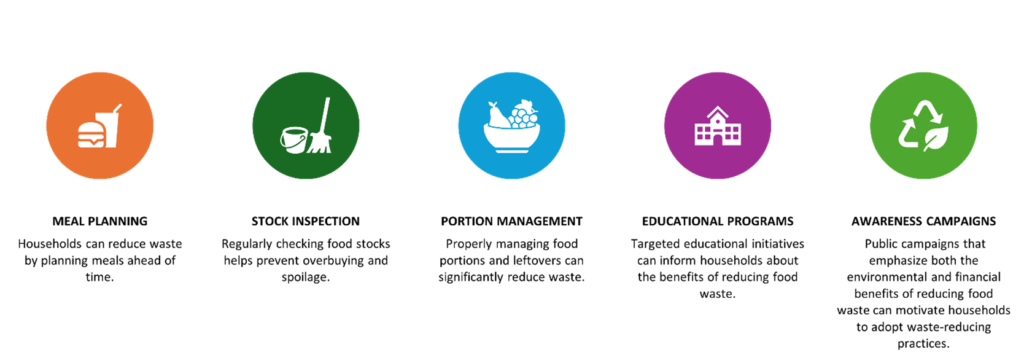Written by: Dr. Ítala Marx
Department of Analytical Chemistry, University of Cordoba, Spain
Chemistry Institute for Energy and Environment, University of Cordoba, Spain
Email: itala.gouveia.marx@uco.es
Food waste is one of the most pressing environmental and social issues today. Approximately 33% of food produced for human consumption (FAO, 2011) is wasted. In the EU, over 58 million tonnes of food waste (131 kg/inhabitant) are generated annually (Eurostat, 2023), with an associated market value estimated at 132 billion euros (SWD (2023)421).

While food waste occurs at all stages of the food supply chain, private households have been identified as key actors in food waste generation. According to the UNEP Food Waste Index 2024, around 1.05 billion tonnes of food waste were generated in 2022 – 60% of which came from households, 28% from food services and 12% from retail. The equivalent of at least one billion meals of edible food is being wasted in households worldwide every single day (UNEP, 2024).
Similarly, in the EU, 70% of the food waste arise from households, food service, and retail sectors (Eurostat, 2023).
Food production is resource-intensive, and food losses and waste lead to significant environmental impact, including soil erosion, deforestation, water and air pollution, and greenhouse gas emissions, all of which occur during food production, storage, transportation, and waste management.
Food waste is a complex, multifaceted issue that cannot be attributed to single variables. Addressing it requires the integration of different disciplinary perspectives. Understanding the factors that influence household food waste is crucial for developing effective communication strategies that promote food waste reduction.
Figure 1 illustrates the key insights for reducing waste in consumers’ houses.

Figure 1. Understanding household food waste: Key insights for reducing waste in consumers houses
A recent study by Simões et al. (2023) in Portugal developed a conceptual model linking food waste to its causes, aiming to inform effective communication strategies. The study utilised an online survey with 376 valid responses. Key findings include moderate correlations between motivations, behaviours, and the amount of food wasted. These variables, alongside age, gender, and household size, helped identify four consumer clusters: impulsive wasters (17%), planners (26%), young wasters (27%), and fans of leftovers (30%). The study also suggests tailored communication strategies for each cluster. For example, impulsive wasters could benefit from shopping tips, while young wasters and fans of leftovers might reduce waste through better storage practices and the use of leftovers. The frequency of communication should be higher for young and impulsive wasters to regularly encourage these behaviours.
In this sense, understanding these consumer segments can help create more effective campaigns to reduce food waste, contributing significantly to sustainable development and addressing food security issues.
To effectively reduce food waste, communication strategies should focus on consumer segmentation. Targeting young wasters with storage and cooking tips and impulsive wasters with shopping tips can maximise waste reduction efforts. Reducing food waste is a crucial step in combating world hunger, driven by factors such as attitudes, values, motivations, habits, customs, knowledge, and behaviours at both individual and family levels.
Aiming to uncover how motivations and food management practices influence waste reduction, Begho and Fadare (2023) examined the role of different motivating factors in reducing household food waste and assessed whether households implement these practices individually or as a bundle. Three main motivations for reducing food waste at home were identified (Figure 2):
- saving resources
- environmental considerations
- emotional reactions to waste
It also pinpointed three key food management practices: planning, inspecting, and proactive management. Among these, “inspecting” food items emerged as the most common management practice, while environmental considerations were the most frequent motivation.
The findings revealed a complementary relationship between different motivation bundles and management practices, suggesting that households tend to use them together rather than in isolation. Proactive food management was found to be the most effective practice in reducing food waste. Motivations related to environmental impact and the emotional distress caused by food waste also significantly encouraged waste reduction.

Figure 2. Main motivation for reducing food waste in households
Understanding the interdependent nature of motivations and practices is crucial for effective food waste reduction. To achieve meaningful progress, policies should emphasize the environmental impact of food waste and integrate educational programs into existing initiatives.
While preventing food waste significantly contributes to sustainable development, more effort is needed to meet the international commitment to halve food loss and waste by 2030, as outlined in the EU Farm to Fork Strategy and Sustainable Development Goal 12.3. Understanding the factors that influence household food waste is essential for developing effective communication strategies. These strategies should aim to motivate consumers to reduce food waste, raise awareness of their role in this issue, and highlight the impact of food waste on sustainability (Figure 3).
By providing a comprehensive understanding of household behaviour related to food waste, we can develop more targeted and effective waste reduction strategies. Focusing on the interconnected nature of motivations and practices will better address the pressing issue of food waste and contribute to a more sustainable future.

Figure 3. Strategies to reduce food waste in households
Bibliography
Eurostat, 2023
https://ec.europa.eu/eurostat/statistics-
SWD (2023)421
explained/index.php?title=Food_waste_and_food_waste_prevention_-_estimates
https://eur-lex.europa.eu/resource.html?uri=cellar:1fefebb0-1b4e-11ee-806b-01aa75ed71a1.0001.02/DOC_5&format=PDF
UNEP Food Waste Index 2024
https://www.unep.org/resources/publication/food-waste-index-report-2024
Simões et al., 2023
Joana Simões, Tânia Pinto-Varela, Margarida Gaspar de Matos, Ana Carvalho. What influences consumer food waste in urban households? Guidelines for communication strategies in Portugal, Journal of Cleaner Production, Volume 429, 2023, 139577, ISSN 0959-6526, https://doi.org/10.1016/j.jclepro.2023.139577.
Begho and Fadare, 2023
Toritseju Begho, Olusegun Fadare. Does household food waste prevention and reduction depend on bundled motivation and food management practices? Cleaner and Responsible Consumption, Volume 11, 2023, 100142, ISSN 2666-7843, https://doi.org/10.1016/j.clrc.2023.100142.

